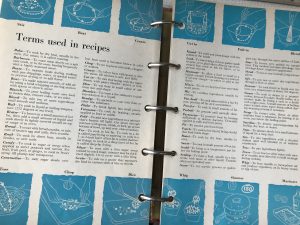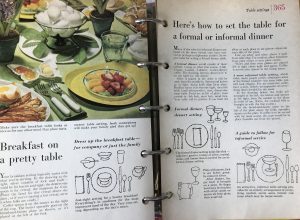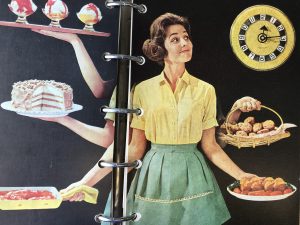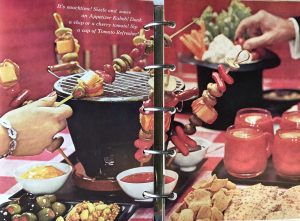🍋 Cookbook Introduction
Better Homes and Gardens new Cookbook printed by Meredith Press is a cookbook that reaches out to those people who have little to no cooking skills. This cookbook is focused on helping anyone and everyone learn how to cook. If this cookbook were to have a motto it would be that “everyone can cook!” The cookbook gives instructions for lots of important food and cooking related topics that beginners would learn or want to know. Food and cooking topics like basic nutrition information (protein, minerals, vitamins, energy), the recommended daily dietary allowances, the food groups (milk, meat, vegetable and fruit, bread and cereal), how to meal plan, how to use ingredients, the correct measuring methods, how to store food, how to remove spots and stains, how to set a table properly, and so on. These are all simple things that someone who is a beginner or someone who doesn’t cook often would find very helpful and informing. More advanced cooks more than likely know all this information. The way the cookbook is written would make the beginner audience feel comfortable. The language and words used are not hard to follow and the steps given are clear. Most of the recipes in the book aren’t too challenging. If you don’t think you can cook, this book would be great for you!


🍋 Example Recipe
| Peanut-butter Cupcakes OVEN 375° |
| 1/2 cup peanut butter
1/3 cup shortening 1 teaspoon vanilla 1 1/2 cups brown sugar 2 eggs 2 cups sifted all-purpose flour 2 teaspoons baking powder 1/2 teaspoon salt 3/4 cup milk |
| Cream together peanut butter, shortening, and vanilla. Gradually add brown sugar, beating till light and fluffy. Add eggs, one at a time, beating well after each. Sift together dry ingredients; add alternately with milk. Place paper bake cups in muffin pans; fill 1/2 full. Bake in moderate oven (375°) 20 minutes or till done. “Frost” with peanut butter. Sift confectioners’ sugar atop each. Makes about 2 dozen.
(pg 108) |
🍋 All About the Cookbook
This cookbook was put together during the Depression era (1930s) and surprisingly became one of America’s favorite cookbooks (at the time). Everyone loved the cookbook so much that it only took about 3 months for it to be on the best-seller list. Cooks especially loved the book for many reasons; the ring binding helped make it lay flat on the counter, the blank pages at the back to allow for jotting down new recipes, and the tabs that divided the cookbook into different sections. In later editions of the Better Homes and Gardens new Cookbook, the recipes were tasted and tested by the Better Homes and Gardens Tasting-Test Kitchen. The recipes included in this cookbook were to be informative and easy to follow because not everyone naturally knows how to cook, bake, or whip up something in the kitchen. These cookbooks focused on giving more instruction than just “a little bit of this and a little bit of that.” They aimed for providing clearer measurements for both those who aren’t so experienced, but also those who just wish for more clarity and direction when cooking. The different editions of the book change with time, changing as America changes. It’s like the cookbook is also a history book traveling from the 1930s until present time. A short timeline of the history provided:
- 1940s – wartime and rationing (the book featured oven meals where the main dish, vegetable, and dessert were all cooked in the oven at the same time)
- 1950s – post war (the book featured grilling in the backyard and ways to entertain)
- 1960s – (a rise in foreign and gourmet meals)
- 1970s – time of the budget crunch (featuring budget meals, crockpot meals, and help from the microwave oven)
- 1980s – decreasing family sizes (the book featured less table setting information and included more healthy eating and nutrition information)
- 1996 – (fast recipes that included the preparation times)
The Better Homes and Gardens new Cookbook has changed to fit the different lifestyles of the decades, but it’s never gone out of style. The cookbook “remained true to its original mission of providing cooks with a trustworthy cooking resource” (A Little Lore on America’s No. 1 Cookbook, 2017).

🍋 The Depression Era
Although there were many different editions of this cookbook that were published. The time frame of the very first published edition was during the Great Depression. The Great Depression was a time of the worst economic crash of all time that lasted from 1929 until 1939. The stock market crashed, consumer investments and spending decreased, production declined, and the unemployment rate was very high (about 15 million Americas were out of jobs). The wages that people did earn were low and the struggles in agriculture were those of food prices falling and drought. The Great Depression ended when all the attention was focused on War War II (Editors, 2009).
The ingredients, forms of measurement, utensils, and techniques required by this cookbook would follow the simplicity needed during the time of the Depression era. The cookbook uses a lot of basic ingredients (things we would even use today). Such as sugar, vanilla, butter, eggs, water, fruits, vegetables. Due to being in the Depression era, not all the recipes given in the cookbook would have been able to be made since there was a decline in agriculture. However, the cookbook provides a bunch of different recipes meaning that some of them were probably doable doing this time. The forms of measurement are pretty similar to those of today as well. Measuring with cups, tablespoons, teaspoons, quarts, etc. The only different form of measurement listed in this cookbook is a “dash” of an ingredient. A “dash” of whatever is probably rarely seen in most of today’s recipes. The costs of the ingredients and utensils were more than likely low due to the time frame. Although, there was a decline in money, middle class people are probably the ones who could still afford some of the ingredients, technology, and utensils to make recipes out of this cookbook. This cookbook is based for everyone to be able to cook, but people also have to be able to afford the products in the recipes. The lower classes probably weren’t able to make many recipes from this book during this time.
🍋 Cookbook Identity
One of the main identities that play a role throughout this cookbook is that of gender roles. This cookbook is aimed at the idea that women do all the cooking and preparing of the food. Men are the ones who do the grilling and who participate more in the dining of the foods than of the preparation of the foods. There are plenty of pictures throughout the book that present a woman’s hands making the recipes. The pictures that do have a man’s presence show him dishing the food to eat it or, as previously mentioned, grilling the meats for a meal. This seems pretty typical coming from this time period though. Most women probably weren’t too involved in the workforce whereas most men probably were. The men make the money and the women are to cook and take care of their families.


Another identity that plays a role in this cookbook is social class. This cookbook’s audience is the everyday kind of person. However, it may exclude the everyday person who might be a part of the lower social class. One has to have the technology to prepare the food (oven, grill, etc.). They also have to be able to afford the ingredients and have containers and such to cook and store the food in. A lot of the pictures throughout the book show nice dish wear especially in the “Table settings” portion of the cookbook. Some pictures also show a woman’s wrist where she’s wearing nice jewelry or a man’s arm where he’s wearing a nice suit. There were a few pictures in the cookbook that showed full outfits which were made up of nice clothes. This cookbook definitely portrays the middle and high class families over those who are in the lower class.

A few other identity markers…
It seems that most pictures show caucasian skin tones. There are some black and white pictures which makes it hard to tell the skin tones in those. The cookbook could provide race and ethnicity, but most of the pictures seem to present one race / ethnicity over incorporating others.
Most of the recipes are from the United States. Other than recipes being pulled from different regions or areas in the U.S., the cookbook doesn’t seem to include foods from other places throughout the world.
🍋 Rhetoric in Better Homes and Gardens new Cookbook
The language and information used in this cookbook provide the idea that anyone can cook. The words are simple and the information provided is helpful to those who don’t know a single thing about cooking. The book gives someone all the tools they need to cook a good meal for their family. The information provided in the cookbook, in a way, persuades the beginner audience that cooking isn’t too hard and that they have the ability to make all the recipes included in the book. However, there are still some recipes in the cookbook that are hard to make. Also, the cookbook provides nutritional information, but also gives a lot of recipes for cakes, candies, desserts, cookies, pastries, and pies. For example, page 10 in the nutrition section gives information on the daily food plan. A plan of what to include in your meals everyday (the 4 groups – milk, meat, vegetable/fruit, bread/cereal). Yet, the book provides more recipes for items that don’t fit into those categories.
🍋 Linkages to Class
- Identity
- Gender roles
- Historical context (industrial revolution – canning, cheaper foods, storage, changes in agriculture, nutrition information)
- Rhetoric (it’s easy to cook…but is it really?)
🍋 References
(2017). A Little Lore on America’s No. 1 Cookbook. Retrieved April 14, 19, from https://www.bhg.com/recipes/how-to/cooking-basics/a-little-lore-on-americas-no-1-cookbook/
Editors, H. (2009, October 29). Great Depression History. Retrieved April 14, 2019, from https://www.history.com/topics/great-depression/great-depression-history